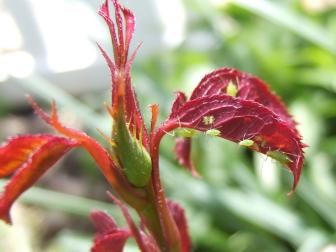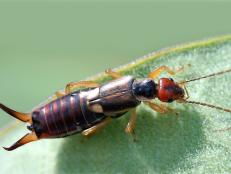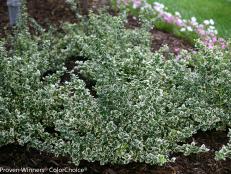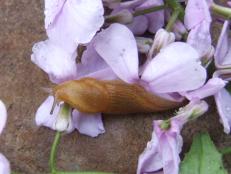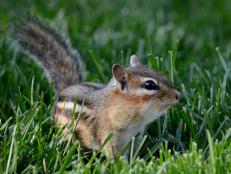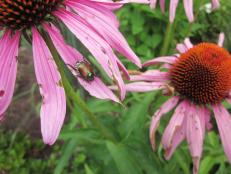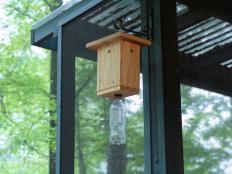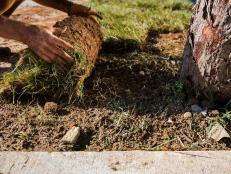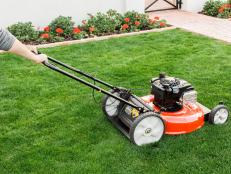How to Get Rid of Carpenter Ants Before They Cause Harm
Learn what carpenter ants look like and how to manage an infestation in your home before the damage is done.


The sight of the largest pest ant in the US crawling across the kitchen floor can be alarming to homeowners who often seek ways to get rid of carpenter ants when they swarm in the spring and early summer.
Carpenter Ant colonies, which can be as large as several thousand ants, are hard to miss when an infestation has set in. Dormant in winter, carpenter ants seek out and destroy damp or rotting wood in which they'll make their nests. And they are very good at it.
What Are Carpenter Ants?
Carpenter ants can be found throughout the US. In the forest, nests chewed into tree stumps or fallen timber aren't a problem. Carpenter ants clean up pest debris in the garden and promote composting of rotting wood.
For homeowners, however, the aggressive damage done by large populations of carpenter ants can damage houses, fences, outbuildings and decks.
While carpenter ants do not sting, their bite is painful and can be hard to avoid in a heavily infested yard.
What Do Carpenter Ants Look Like?
Carpenter ants are black or red and black. Wingless workers usually range in size from 3/8 inch to 1/2 inch, while males and queens are larger. Queens can be as large as an inch long, though you'll probably never see one. Carpenter ants have narrow waists and bent antennae while males and queens can have wings, though the queens lose their wings when they start a nest.
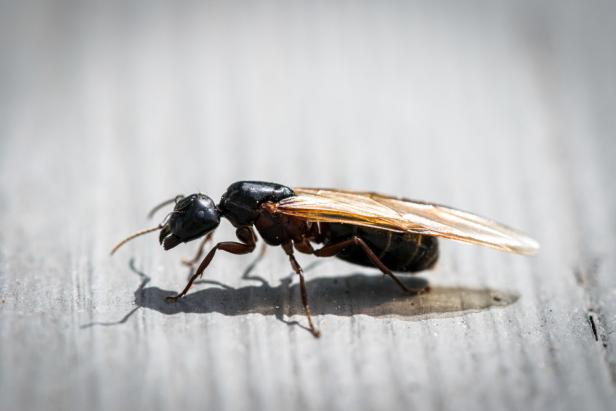
Shutterstock/MainelyPhotos
Males carpenter ants and queens can have wings, though the queens lose their wings when they start a nest. But don't confuse carpenter ants with termites. Winged termites' wings are of equal lengths whereas the hind wings on carpenter ants are shorter than the front wings.
Don't confuse carpenter ants with termites. Termites are light-colored with broad waists and straight antennae. Winged termites are dark colored, however their sets of wings are of equal lengths whereas the hind wings on carpenter ants are shorter than the front wings.
If uncertain whether you're looking at a termite or a carpenter ant, you can send a sample to your local extension service for identification.
What Do Carpenter Ants Eat?
Carpenter ants do not eat wood as termites do.
In the garden, carpenter ants feed on the honeydew (a sweet, sugary excrement) produced by aphids, scales and other plant-damaging insects. They also feed on dead insects for protein.
In the home, carpenter ants will eat pet food and meats, as well as jelly, sugar, syrup and other sweets.
How Do Carpenter Ants Get Into a Home?
Carpenter ants seldom tunnel into dry, sound wood. But indoor nests can be found in such places as door casings, sills, joists, wall studs, porch pillars, crawlspaces, and around sinks or tubs. Carpenter ants can also excavate soft materials such as foamed plastic insulation board.
Signs there may be a carpenter ant nest in your home include course sawdust, multiple sightings of carpenter ants indoors or if you see large numbers of winged carpenter ants in late winter through spring.
Damage can vary depending on the size of the colony. While damage can happen quickly, it would be localized to the area of the damp wood, says Caroline Kirby, technical director at Plunkett's Pest Control.
But the presence of carpenter ants indoors may not necessarily mean there's an indoor nest. Ants indoors could be traveling from their outdoor nests to forage for food in your home.
Homeowners can track the nocturnal carpenter ants' movements at night to find their nests. Since the ants make their nests in damp wood, their movements could lead homeowners to water damage needing repair. "The presence of carpenter ants can actually be an indication of a bigger problem," says Dan Suiter, a professor of urban entomology with the College of Agricultural and Environmental Sciences at the University of Georgia.
Suiter says the nocturnal carpenter ants are easy to follow at night. You can get close to the ants, but Suiter advises to cover your mouth as your breath will disturb them. You can use a flashlight, but cover the bulb with a red filter (or cover a portion of the light with a hand).
Getting rid of a carpenter ant infestation can be difficult, but steps can be taken to reduce the damage done by these destructive visitors.
How to Get Rid of Carpenter Ants?
Destroy nests. The best way to get rid of carpenter ants is to destroy their nests, indoors or outdoors. Outdoor nests are commonly found in tree holes. If a carpenter ant nest is discovered, it is possible to remove it by removing the infested wood, but extended nesting locations are often overlooked and may warrant professional assistance.
Limit nesting opportunities. Clear out fallen branches from the yard, remove rotting tree stumps and prune dead branches from trees. Keep tree branches from touching your home's roof. Water-damaged wood on structures should be repaired, and store firewood or lumber away from structures.
Avoid standing water. Level ground along fences or structures where water may pool, clean your gutters, and repair any leaky gutters or downspouts. Install moisture barriers under porches and other water-prone locations.
Remove food supplies. Control of honeydew-producing pests in the garden may discourage a developing carpenter ant colony. Carpenter ants covet aphids and will tend to them much like a farmer tends to livestock, even carrying them between plants to promote their favorite food source.
How to Get Rid of Aphids
Find out from the garden experts at HGTV how to identify and get rid of aphids.
Keep food sources out of reach indoors, too. "Remove anything that the pests need to survive," says Kirby. "Sanitation practices such as cleaning up spills or putting away food will discourage a lot of the pests that are most commonly found in homes."
Chemical treatment. If a nest cannot be detected, the use of chemicals may be necessary. Spray insecticides are usually ineffective against a large nesting colony. Baiting with an ant gel can control a carpenter ant population but requires diligence. Bait must be placed where ants have been spotted and replaced regularly until problems subside. Again, hiring a professional pest control service to manage a chemical solution may be the most reliable course of action to put an end to a carpenter ant infestation before further damage to property is incurred. Professional pest control companies will apply a chemical barrier around your home.






